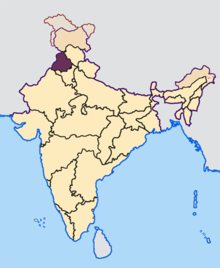Punjabi folk religion
Punjabi folk religion incorporates local mysticism [1] and refers to the beliefs and practices strictly indigenous to the Punjabi people, of the Punjab region including ancestral worship, worship of indigenous gods, and local festivals. There are many shrines in Punjabi folk religion which represents the folk religion of the Punjab region which is a discourse between different organised religions.[2] These shrines represent inter-communal dialogue and a distinct form of cultural practice of saint veneration.[3]
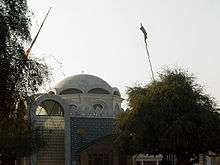
Punjabi folk cosmology
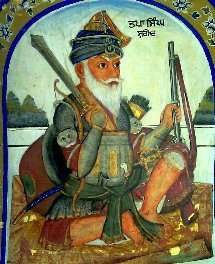
Punjabis, irrespective of their organised religion, continue to practice Punjabi folk religion which at times runs independently of organised religion or derives beliefs from institutionalised religions which then form part of Punjabi folk religion.
In Punjabi folk cosmology, the universe is divided into three realms:[4]
| English | Punjabi | Inhabitants |
|---|---|---|
| Sky | Akash | Dev Lok (Angels) |
| Earth | Dharti | Matlok (Humans) |
| Underworld | Nagas | Naglok (Serpents) |
Devlok is the realm of the gods, saints and ancestors, existing in akash, the sky. Ancestors can become gods or saints.[4]
Punjabi ancestral worship
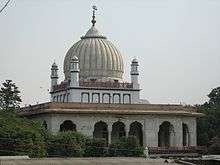
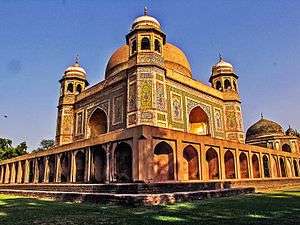
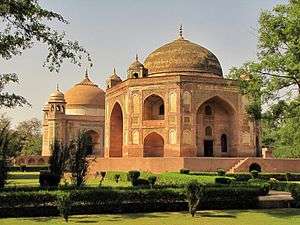
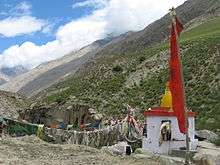
Jathera—ancestral shrines
A jathera is a shrine constructed to commemorate and show respect to the founding common ancestor of a surname and all subsequent common clan ancestors.[4]
Whenever a founder of a village dies, a shrine is raised to him on the outskirts of the village and a jandi tree is planted there. A village may have many such shrines.
The jathera can be named after the founder of the surname or the village. However, many villages have unnamed jathera. In some families, the founder of the jathera is also a saint. In such instances, the founder has a dual role of being the head of a jathera (who is venerated by his descendants) and also of being a saint (such as Baba Jogi Pir; who can be worshiped by any one).[4]
Punjabi surname lineage
Punjabi people believe that members of a surname all hail from one common ancestor. A surname in Punjabi is called a gaut or gotra.[4]
Members of a surname are then subdivided into smaller clans comprising related members who can trace their family tree. Typically, a clan represents people related within at least seven generations but can be more.[5]
In ancient times, it was normal for a village to comprise members of one surname. When people moved to form a new village, they continued to pay homage to the founding jathera. This is still the case for many people who may have new jathera in their villages but still pay homage to the founding ancestor of the entire surname.[4]
Over time, Punjabi villages changed their composition whereby families from different surnames came to live together. A village therefore can have one jathera which can be communally used by members of different surnames but has the founder of the village as the named ancestor or many jathera can be built to represent the common ancestors of specific surnames.[6]
When members of a clan form a new village, they continue to visit the jathera in the ancestral village. If this is not possible, a link is brought from the old jathera to construct a new jathera in the new village.[4]
Attendance
People visit the jathera when getting married, the 15th of the Indian month and sometimes on the first Sunday of an Indian month. The descendants of the elder go to a pond and dig earth and make shivlinga and some put it on the mound of their jathera and offer ghee and flowers to the Jathera.So, It is a form of shivlinga puja also. In some villages it is customary to offer flour.[4]
Veneration
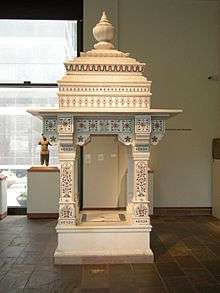
Jathera veneration is not strictly a part of organised religion and forms part of Punjabi folk religion. Jathera veneration in Punjab does not take the same form as in organised religion and is seen as showing respect to elders.
List of jathera
| Jathera | Surname |
|---|---|
| Pir Baba Kala Mehar | Sandhu Jat |
| Daadi Chiho ji,Banga | Parmar |
| Baba Jogi Pir | Chahal Jat |
| Baba Kaallu Nath | Romana |
| Baba Sidh Kalinjhar | Bhullar Jat |
| Lakhan Pir | Cheema Jat |
| Talhan | Sehgal |
| Pir Baddon Ke | Cheema Jat |
| Sidhsan | Randhawa Jat |
| Tilkara | Sidhu Jat |
| Talwan | Jandu |
| Sidh Surat Ram, | Gill Jat |
| Tulla | Bassi |
| Phalla | Dhillon clan Jat of Maharampur |
| Samrai | Kapila |
| Hakim Pur | Korpal |
| Adi | Garcha Jat |
| Jathera in village Takhni, Hoshiarpur | Guggi |
| Baba Mana Ji | Shergill Jat |
| Baba Kartar Singh Ji,Jamalpur ASR | Aulakh Jat |
| Baba Siria ji ( village Talwandi Khurd, Dist. Mullanpur Punjab) | Dubb |
| Baba Kuldhar ji ( village Ghudani Kalan, Dist. Ludhiana Punjab) | Kashyap Gotra Brahaman |
| Andloo, District Ludhiana, Punjab | Sootdhar |
Fairs
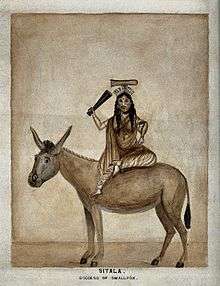
The following are some fairs celebrated in Punjab.
Baba Kaallu Nath Mela
A large Mela is organized at village Nathana (near Bhucho Mandi) in district Bathinda in the month of February–March in honor of Baba Kaallu Nath of the Romana surname. The Mela lasts for four days. The first day is especially for Romana's and three days for all people to attend.
Baba Kala Mehar Mela
A Mela is held in honor of Baba Kala Mehar every year in Amritsar district.
The fair takes place in and around April each year with Sandhu Jats and people from other clans and tribes attending from around Punjab and Rajasthan.
According to legend, Baba Kala Mehar used to tend to his cattle and one day while doing so, he happened to meet Baba Gorakh Nath (Gorakshanath). Baba Gorakh Nath asked Pir Baba Kala Mehar if he can give him some milk from his buffaloes. A miracle happened that while the cattle being tended at that time were all bulls, Baba Ji is said to have miraculously taken milk out of bulls on striking them with his stick.
Baba Jogi Pir Mela
The village of Bhopal falls in the Mansa tehsil of Bathinda district.
The village is known for the fair of Baba Jogi Pir[7] who is said to be the guru (preceptor) of Chahal Jat. It is said that during the times of Mughal rule, Baba Jogi Pir fought against the forces of the Mughal rulers.
During the battle, his head was chopped off, but his headless body kept on fighting until it fell down dead in this village. The people were deeply touched by the sacrifice of Jogi Pir, constructed a shrine, and began to hold a fair.[7]
Another legend narrates that once a few people stayed under a grove of trees in the premises of the shrine. They felt pangs of thirst at night, but there was no source of water where from they could quench their thirst . A heavenly voice which was believed to be that of Jogi Pir was heard: “why do you die of thirst? Pick out a brick from the pond and take water”. They did likewise, found water from underneath the brick they picked up and thus they quenched their thirst.[7]
A fair is held twice annually for three days on Bhadon 28 (August–September)and Chet 16 (March- April) at the shine of Jogi Pir. It is attended by both Hindus and Sikhs. The people pay their obeisance at the shrine, especially after the birth of a child or the solemnization of marriage. Earth is also scooped one of the tank by the people for invoking the blessings of Jogi Pir.[7]
Shrines
Shrines in honour of saints are common in the Punjab region. A Shaheed Shrine is a building constructed to commemorate and show respect to a saint.[8] Muslim shrines are referred to a dargahs and Hindu shrines are known as samadhs.
Khawaja Khidr
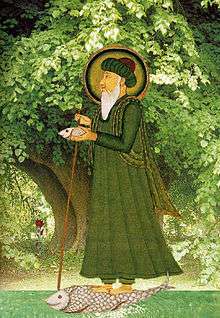
In the Punjab region, Khawaja Khidr is a river spirit of wells and streams.[9] He is mentioned in the Sikandar-nama as the saint who presides over the well of immortality, and is revered by many faiths.[9] He is sometimes pictured as an old man dressed in green, and is believed to ride upon a fish.[9] His principal shrine is on an island of the Indus River by Bhakkar in Punjab, Pakistan.[9]
Sanjhi
Sanjhi is a festival dedicated to the Mother Goddess. Chowk poorana art is drawn on walls to celebrate the festival.
Gugga Pir
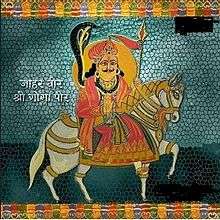
Gugga Pir is venerated for protection against snakes. The fair known as Chhapar Mela is organised annually.
Khetri and Goddess Gorjas farm
Traditionally, on the first day of Navratri people in Punjab sow pulses, cereals and other seeds in a pot which is watered for nine days at the end of which the seeds sprout. This custom is known as "Khetri". It signifies prosperity and abundance. It is very important to plant grains of barley in a pot. On the tenth day, the shoots are about 3 - 5 inches in length. On Dussehra Goddess Gorja (Goddess Parvati),[10] in the form of seedlings, is covered with a piece of red cloth and worshipped and propitiated. After saying prayers, these seedlings or the "Khetri" is submerged in water on Dussehra. This custom suggests a link to harvesting. The sowing and reaping of barley is symbolic of the "first fruit".[11][12]
Accordingly, Punjabi farmers traditionally start to harvest the kharif (monsoon) rice crops after Dussehra and sow the wheat (rabi crop) after Diwali. Therefore, Dussehra doubles up as a thanksgiving festival and Diwali is also considered to be a harvest festival.
Sakhi Sarwar
Many villages in Punjab, India and Pakistan, have shrines of Sakhi Sarwar who is more popularly referred to as Lakha Data Pir. There is a shrine of pir sakhi sarwar in district Dera Ghazi Khan in Punjab provence of Pakistan. There is great fair held in March every year at the shrine of Lakh data pir. Village name is also sakhi sarwar. It is 34 km far away from Deara Ghazi Khan. A 9-day fair is organised every year in Mukandpur, Punjab, India.
Seetla Mata
Seetla Mata is worshiped for protection against childhood diseases. A notable fair is held annually in Ludhiana district and is known as the Jarag mela.[13]
Gorakhnath
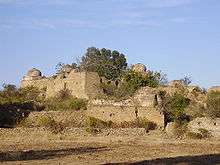
Gorakhnath was an 11th to 12th century[14]Nath yogi, connected to Shaivism as one of the two most important disciples of Matsyendranath, the other being Caurangi. Gorakhnath healed Puran Bhagat.
Puran Bhagat
Puran Bhagat is a revered saint in the Punjab region and other areas of the subcontinent. He was the Prince of Sailkot and the son of Raja Sálbán.[15] He is also worshipped as Baba Sahaj Nath Ji. Puran Bhagat received spiritual training from Gorakhnath after spending time in a well as a child, on the orders of his father.
People visit Puran's well located in Sialkot, especially childless women travel from places as far as Quetta[16] and Karachi.
Seasonal festivals
Punjab is a state involved in agriculture. For this reason Punjabis continue to show respect to the seasonal festivals of Lohri, Basant Panchami Festival, Baisakhi and Teeyan. Over time some seasonal festivals have come to coincide with religious festivals but the original meaning of the festivals has not been lost.
References
- Nagendra Kr Singh, Abdul Mabud Khan (2001) Encyclopaedia of the World Muslims: Tribes, Castes and Communities, Volume 3. Global vision
- Replicating Memory, Creating Images: Pirs and Dargahs in Popular Art and Media of Contemporary East Punjab Yogesh Snehi "Archived copy". Archived from the original on 2015-01-09. Retrieved 2015-01-09.CS1 maint: archived copy as title (link)
- Historicity, Orality and ‘Lesser Shrines’: Popular Culture and Change at the Dargah of Panj Pirs at Abohar,” in Sufism in Punjab: Mystics, Literature and Shrines, ed. Surinder Singh and Ishwar Dayal Gaur (New Delhi: Aakar, 2009), 402-429
- "Centre for Sikh Studies, University of California. Journal of Punjab Studies Fall 2004 Vol 11, No.2 H.S.Bhatti and D.M. Michon: Folk Practice in Punjab". Archived from the original on 2016-03-03. Retrieved 2010-01-05.
- This is not definitive
- A Glossary of the tribes & castes of Punjab by H. A Rose
- Gazetteer of Bathinda 1992 Edition
- Sandip Singh Chohan, Thesis for the University of Wolverhampton: The Phenomenon of possession and exorcism in North India and amongst the Punjabi Diaspora in Wolverhampton
- Longworth Dames, M. "Khwadja Khidr". Encyclopedia of Islam, Second Edition. Retrieved 21 April 2012.
- http://www.nameandfame.org/g.html
- "Archived copy". Archived from the original on 2001-03-03. Retrieved 2014-12-31.CS1 maint: archived copy as title (link)
- http://www.webindia123.com/punjab/festivals/festivals1.htm
- http://www.discoveredindia.com/punjab/fairs-and-festivals-in-punjab/fairs/ludhiana-jarag-mela-martyr-fair.htm
- Briggs (1938), p. 249
- Ram, Laddhu. Kissa Puran Bhagat. Lahore: Munshi Chiragdeen.
- Dawn 8 October 2012
